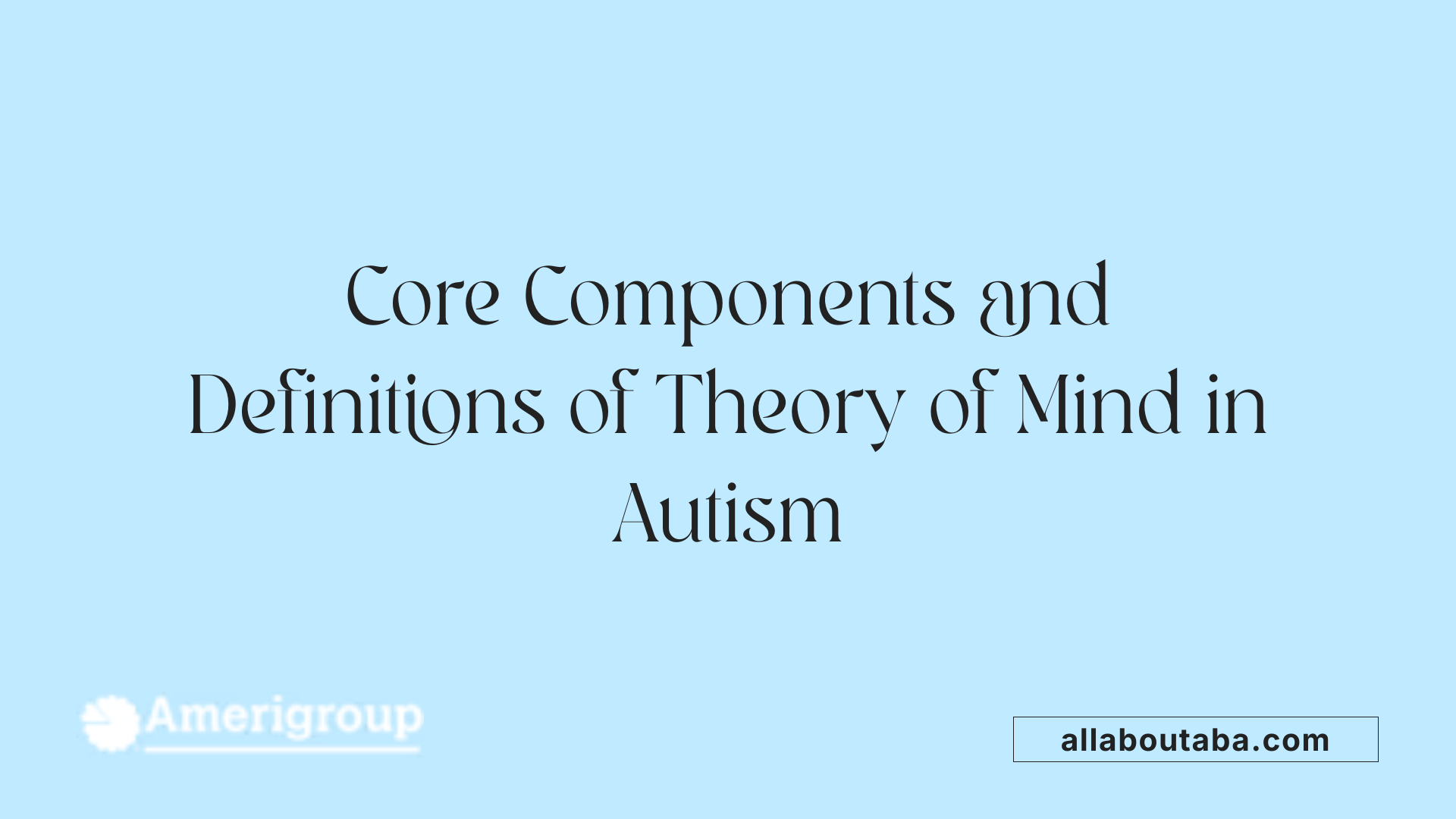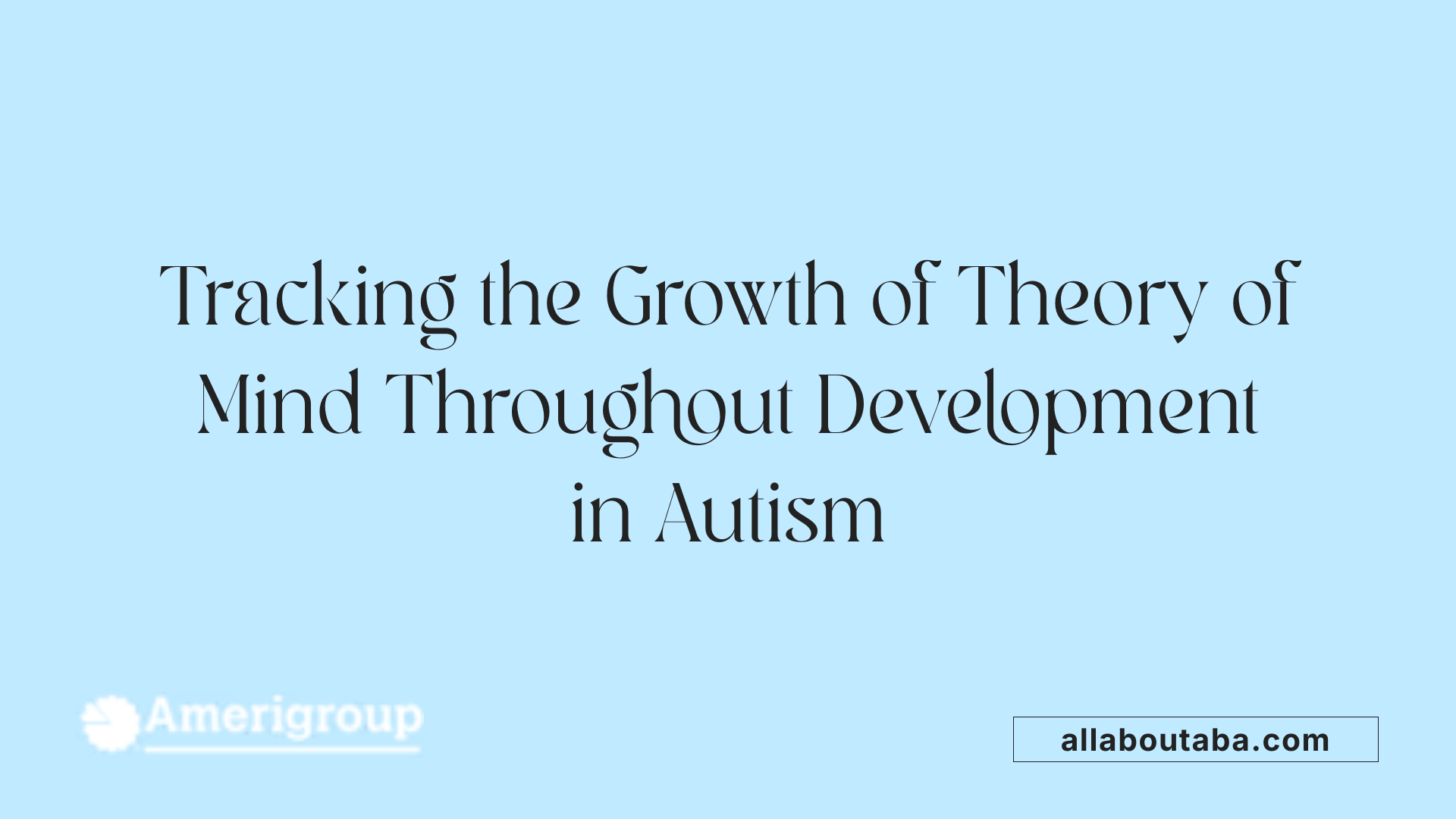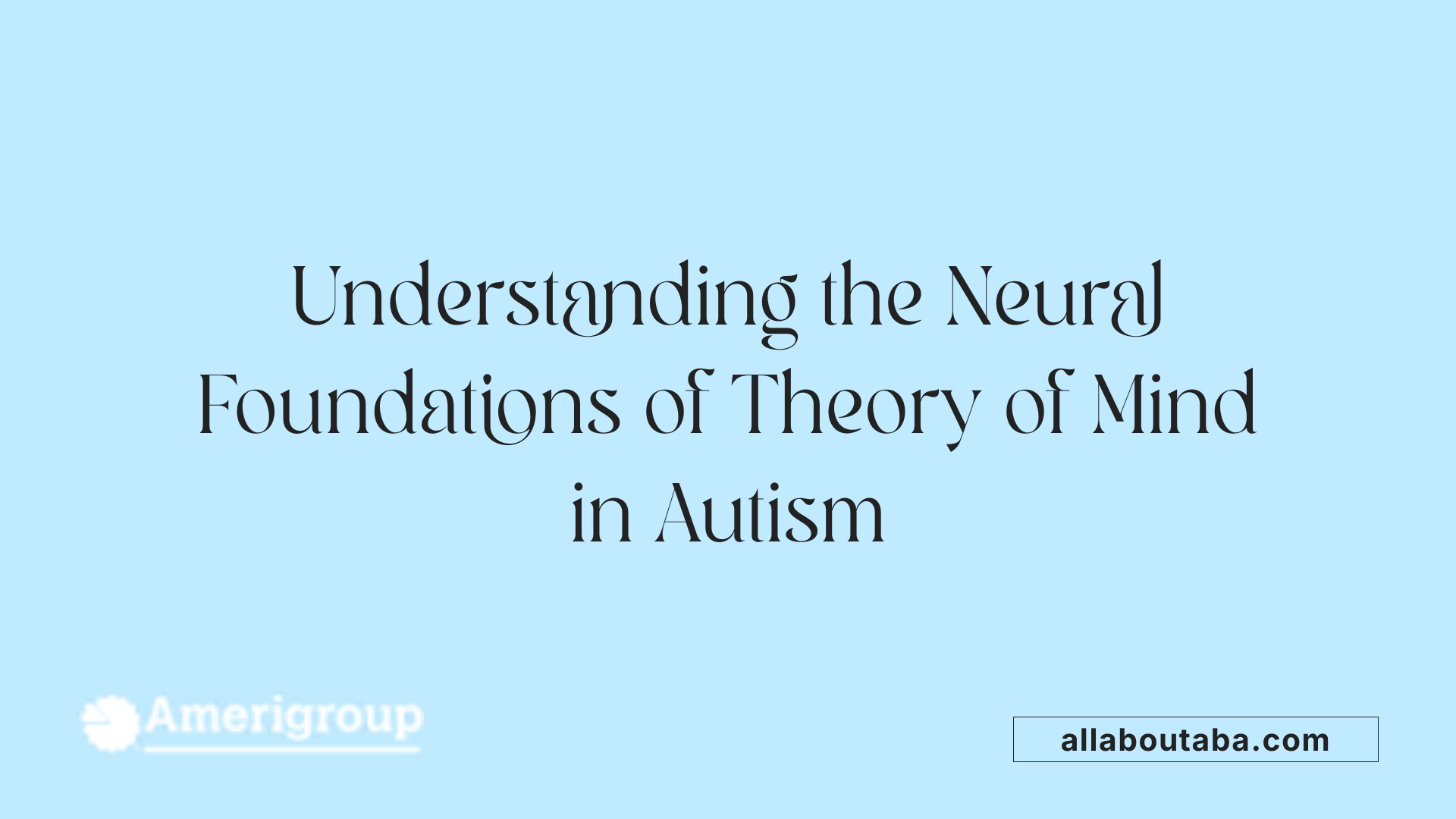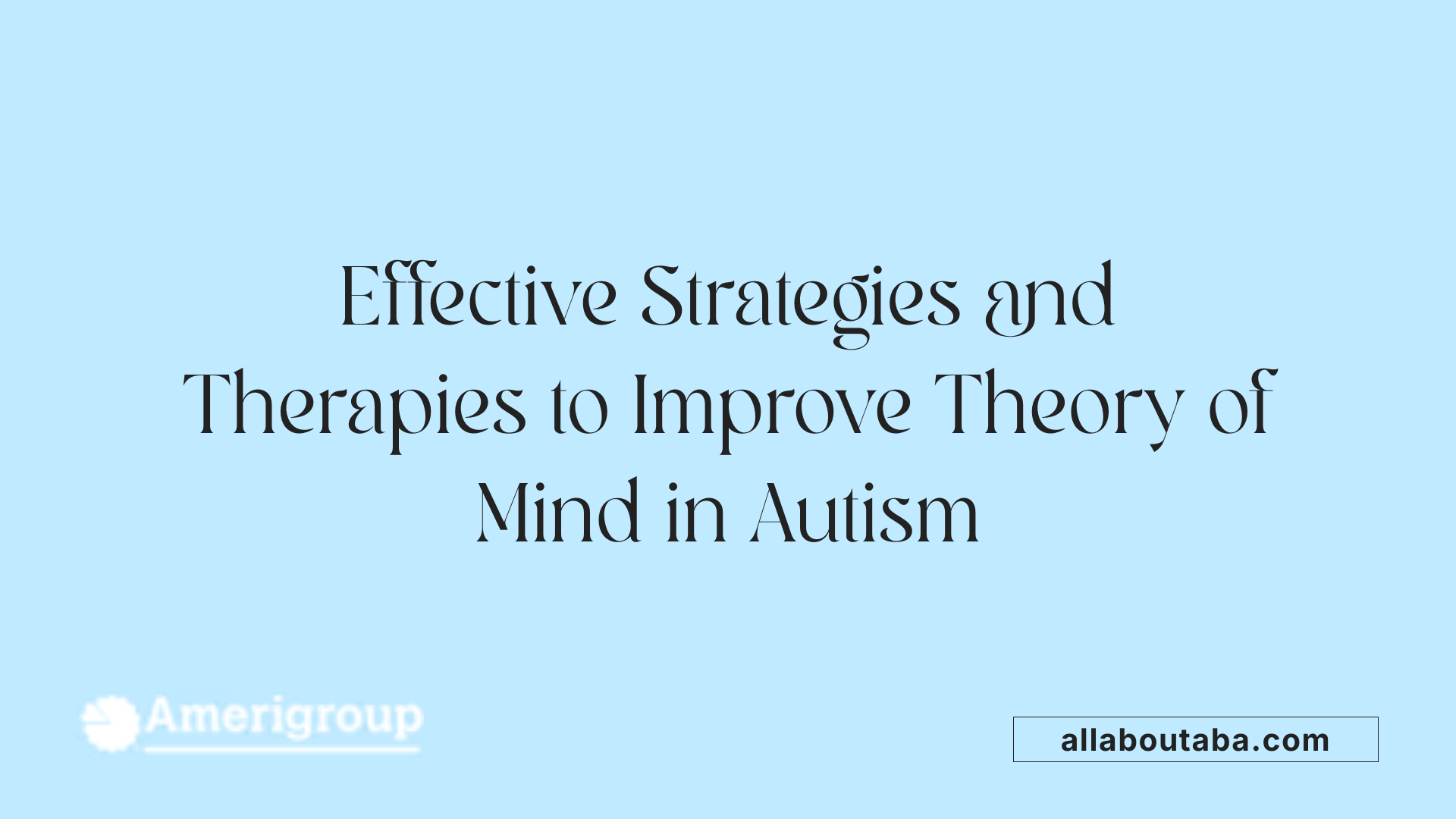Understanding the Cognitive Basis of Social Interactions in Autism
The concept of Theory of Mind (ToM) provides a framework to explore how individuals understand and interpret others' mental states, which is particularly relevant in autism spectrum disorder (ASD). As a fundamental aspect of social cognition, ToM influences communication, empathy, and social behavior. Recent research highlights the complexities and heterogeneity of ToM abilities in autistic individuals, prompting a nuanced approach to assessment and intervention.
Defining Theory of Mind and Its Core Components

What is the concept of Theory of Mind and its relevance to autism?
Theory of Mind (ToM) is the ability to understand, interpret, and attribute mental states such as beliefs, desires, and intentions to oneself and others. This skill is fundamental for navigating social interactions, predicting behaviors, and understanding others’ perspectives.
In autism spectrum disorder (ASD), impairments in ToM are often seen as a core feature. These difficulties can lead to challenges in reading social cues, understanding others’ intentions, and grasping concepts like false beliefs or pretend play.
Recent research introduces the ‘double empathy challenge,’ which frames ToM as a reciprocal process. Instead of viewing deficits as solely within autistic individuals, this perspective suggests misunderstandings often stem from differences in social and communication styles between autistic and neurotypical people.
Autistic individuals may develop ToM abilities at different patterns and speeds, with some showing improvements during adolescence and adulthood. Despite this, spontaneous social cognition and real-time perspective-taking can remain challenging.
Understanding these nuances emphasizes the importance of tailored social skills interventions and mutual understanding. Recognizing that differences in ToM processing are not always deficits but variations can foster better communication and empathy, ultimately improving social experiences for autistic individuals.
What are the distinctions between explicit and implicit ToM?
ToM can be subdivided into explicit and implicit components.
Explicit ToM involves conscious reasoning about others’ mental states. Tasks like the classic false belief tests require individuals to deliberately consider what someone else believes, demonstrating higher-level, reflective mentalizing.
Implicit ToM, on the other hand, reflects spontaneous, automatic processing of social cues without conscious deliberation. For example, infants can anticipate others’ actions based on observed beliefs, even if they cannot verbally explain these mental states.
Studies show that children with ASD often perform better on explicit ToM tasks than on implicit ones, with some able to pass explicit tests but struggling with spontaneous, real-time understanding.
How are mental states represented in ToM?
Representation of mental states involves understanding that individuals’ thoughts, feelings, desires, and intentions can differ from one another and influence behavior.
This involves recognizing that others have minds with beliefs and desires that are hidden or false — a critical point assessed in false belief tasks like the Sally-Anne test.
Recent advancements include the development of new assessments, such as the Interview Task, which measure the accuracy of inferences about mental states, providing a more nuanced understanding of ToM capabilities.
Exploring these core components helps clarify where challenges in social cognition arise in autism and guides effective intervention strategies aimed at improving perspective-taking and empathic communication.
Historical Perspectives and Early Theories in ASD
Origins of ToM hypothesis in autism
The concept of Theory of Mind (ToM) in relation to autism originated in the mid-1980s. Researchers like Simon Baron-Cohen and colleagues proposed that a core difficulty for individuals with autism was a deficit in understanding that others have different mental states, such as beliefs, desires, and intentions. This hypothesis suggested that difficulties with mentalizing, or 'mind-reading,' contributed significantly to the social and communication challenges observed in autism.
Classic false belief studies
A foundational method for assessing ToM was the false belief task, famously exemplified by the Sally-Anne test. In this task, children are asked where Sally will look for her ball after it has been moved without her knowledge. Typically developing children pass this test between ages 4 and 6, demonstrating an understanding that others can hold beliefs different from reality. However, children with autism often fail these tests until much later or show limited spontaneous understanding, which was initially interpreted as a fundamental 'mind-blindness.'
Initial assumptions about 'mind-blindness'
The early view cast autistic individuals as inherently 'mind-blind,' incapable of attributing mental states to others. This idea supported the belief that social impairments stemmed from a core cognitive deficit in mentalizing. Such assumptions led to the development of intervention strategies aimed at teaching ToM skills, hoping to bridge the social communication gap.
Over time, research has challenged this simplistic view. Evidence has shown that some autistic individuals, especially high-functioning ones, can pass explicit ToM tasks, and that social misunderstandings often arise from differences in communication styles rather than an inability to comprehend mental states. Recent perspectives now consider ToM as a complex, multifaceted process influenced by various cognitive factors, including language, executive functions, and individual differences.
Evolution of understanding
The understanding of ToM in autism has shifted from a deterministic stance to a recognition of heterogeneity within the spectrum. Advances in assessment methods, such as virtual reality and more naturalistic testing, have allowed researchers to study ToM in ecologically valid settings. These innovations have highlighted that social cognition in autism is nuanced, involving both strengths and challenges depending on context and individual traits.
Overall, the historical trajectory reflects a move from viewing ToM deficits as a uniform core impairment to appreciating the complexity and variability of social understanding in autism. This evolution underscores the importance of personalized interventions and a more comprehensive view of social cognition in ASD.
Developmental Trajectory of ToM in Autistic Individuals

How does Theory of Mind relate to assessments and development in individuals with autism?
Assessing Theory of Mind (ToM) in autistic individuals involves examining their capacity to understand others' beliefs, intentions, and feelings through various tests. Traditional measures like the false belief tasks, such as the Sally-Anne test, are still widely used but have limitations, especially given that many individuals with autism do not pass these tests until later or perhaps never in spontaneous contexts.
To address these issues, researchers have developed more sophisticated assessment tools that deconstruct ToM into different components. For example, the new Interview Task compares participants' inferences with the actual mental states to evaluate their understanding more accurately. Such tools aim to reveal subtle differences in how autistic individuals process social information.
The development of ToM is often delayed and differs from typical trajectories in children with autism. Typically developing children start understanding intentions and desires by age 2-3, and beliefs by age 4-6. However, children with autism often show delays, with some not passing standard false belief tasks until after age 11, and variation in their abilities continues into adolescence.
Research indicates that factors like age, language development, and general cognitive skills significantly influence ToM development in autism. Higher language skills, especially rich vocabulary and pragmatic language, correlate with better ToM performance.
Targeted interventions, including emotion recognition training and joint attention exercises, have demonstrated improvements in specific ToM skills. Nevertheless, evidence for these gains transferring to real-world social interactions and remaining durable over time remains limited. This underscores the importance of comprehensive assessment approaches that consider both explicit knowledge and spontaneous, applied social understanding.
In summary, understanding the assessment and development of ToM in autism helps tailor interventions, enhances diagnostic accuracy, and provides insights into the social challenges faced by autistic individuals. Recognizing individual differences, from developmental delays to preserved abilities, is vital for supporting social communication growth.
Neural and Cognitive Bases of ToM in Autism

What are the empirical findings on Theory of Mind in autism?
Research into the neural and cognitive underpinnings of ToM in autism reveals a complex picture. Neuroimaging studies show that typical ToM activation patterns in brain regions like the temporoparietal junction and medial prefrontal cortex can be atypical in autistic individuals. Some studies report hypoactivation or different activation patterns during mentalizing tasks, which may contribute to observed difficulties in understanding others' beliefs and intentions.
Cognitively, executive functions such as working memory, cognitive flexibility, and inhibitory control are closely linked with ToM performance in children and adults on the spectrum. Deficits in these areas can hinder the inference processes required for mental state attribution. For instance, challenges with planning or shifting attention may impair the ability to interpret social cues effectively.
Language abilities also significantly influence ToM development. Higher language skills correlate with better performance on false-belief tasks and real-world social understanding. Many autistic individuals show delays or differences in pragmatic language, which impacts the application of ToM in everyday interactions.
Recent models, including the Mind-space framework, emphasize the inference process and individual traits over a simple impairment label. Studies utilizing diverse assessment tools, such as neuroimaging and the newly developed Interview Task, highlight that autism-related ToM differences are not universally deficient but rather nuanced and domain-specific.
While some autistic individuals, especially those with higher functioning, can pass explicit ToM tests, they often struggle with spontaneous mentalizing and real-life social situations. Interventions focusing on language and executive function training show promise in enhancing certain ToM skills, although generalization remains a challenge.
In summary, empirical findings point to a multifaceted neural and cognitive profile underpinning ToM in autism. Recognizing individual differences and the influence of interconnected cognitive domains is crucial for developing targeted support strategies and understanding the heterogeneity within the autism spectrum.
Interventions and Therapies Targeting ToM Enhancement

Are there therapeutic approaches aimed at improving Theory of Mind in individuals with autism?
Yes, various therapeutic strategies have been developed to enhance Theory of Mind (ToM) skills in individuals with autism. These interventions generally focus on teaching social cognition, understanding others' beliefs, emotions, and intentions, and improving social communication.
One common approach is social skills training, which involves structured lessons and activities designed to teach children and adults how to interpret social cues, recognize emotions, and respond appropriately. Many programs incorporate role-playing, social stories, and video modeling to simulate real-life interactions.
In addition to general social skills approaches, targeted ToM-specific programs have shown promising results. These programs are explicitly focused on understanding beliefs, false beliefs, pretense, and other mental states. For example, some 16-week training regimes have produced measurable gains in children's ability to grasp beliefs and false beliefs. While improvements are evident in controlled assessments, translating these gains into everyday social interactions remains a challenge.
Research including meta-analyses indicates that interventions like emotion recognition training and joint attention activities can lead to small but positive effects. These programs aim to improve the ability to read facial expressions, vocal tones, and gestures—skills closely linked to ToM. However, the overall evidence is limited by the low quality of many studies, and findings often show limited transfer or generalization outside training settings.
Despite the progress, limitations persist. Many interventions demonstrate improvements in task-based assessments but fail to produce significant changes in real-world social functioning. Additionally, individual differences—such as IQ level, language skills, and severity of autism—affect the effectiveness of therapies. As a result, ongoing research continues to seek ways to adapt and optimize interventions for broader and more sustainable benefits.
| Intervention Type | Focus Area | Effectiveness | Limitations |
|---|---|---|---|
| Social Skills Training | Enhancing social behaviors | Moderate improvements; better understanding in clinical tasks | Limited generalization to everyday life |
| ToM-specific Programs | Understanding beliefs, false beliefs | Significant in assessments; limited real-world impact | Transfer and maintenance are limited |
| Emotion Recognition & Joint Attention | Reading facial cues, social attention | Small positive effects; variable across studies | Low-quality evidence; limited long-term data |
Overall, while targeted therapies for ToM show promise, their long-term impact on daily social functioning remains uncertain. Continued research aims to refine these methods and develop integrated approaches that can produce lasting, meaningful improvements in social understanding for individuals with autism.
Contemporary Perspectives and the Double Empathy Model
What are the implications of differences in Theory of Mind for social communication in autism?
Differences in Theory of Mind (ToM) in individuals with autism can lead to significant challenges in understanding and interpreting others' perspectives, intentions, and emotions. This can make social interactions more difficult, affecting relationship building and everyday communication.
While some social skills related to ToM can be teachable and improve with targeted interventions, spontaneous application—how people naturally read social cues and respond—is often still impaired in autistic individuals. This gap contributes to pragmatic language difficulties, trouble with joint attention, and understanding social rules, which are all important for smooth communication.
Recent research highlights that ToM differences are diverse within the autism spectrum. Instead of viewing these as mere deficits, many experts now see them as part of a broader picture involving mutual understanding and reciprocity. The 'double empathy problem' emphasizes that social difficulties are not solely caused by autistic individuals' impairments but also by mutual misunderstandings between autistic and neurotypical people.
This perspective suggests that social communication challenges originate from differences in social processing styles rather than a simple lack of mentalizing ability. Consequently, approaches to support social skills should consider both explicit training and the natural social interactions where spontaneous ToM is used.
Overall, recognizing the heterogeneity in ToM abilities encourages more personalized and empathetic strategies, fostering better mutual understanding and allowing more effective communication in real-world settings.
The Double Empathy Challenge and Reciprocal Understanding

What are the main theories of autism related to social cognition?
Theories explaining social cognition differences in autism are varied and highlight different mechanisms. The traditional domain-specific Theory of Mind (ToM) impairment suggests that autistic individuals have specific difficulties in understanding others' mental states, such as beliefs, desires, and intentions. This is supported by performance in false belief tasks, where many autistic individuals struggle to predict or interpret others' thoughts.
In addition to ToM deficits, attention-based theories emphasize challenges in social attention, including reduced gaze and struggles with joint attention, which is the shared focus on objects or people critical for social learning. However, debates persist over whether these attention differences are innate or develop as a consequence of experience.
Other perspectives focus on executive dysfunction, proposing that challenges in planning, cognitive flexibility, and inhibitory control hinder social understanding. Weak central coherence theories argue that autistic individuals tend to focus on details rather than the overarching social context, impeding holistic social comprehension.
Furthermore, some theories consider perceptual and sensory processing impairments as core issues, leading to difficulties in processing social cues like facial expressions and vocal tones. These different theories collectively suggest that social cognition challenges in autism are multifaceted, involving the interaction of cognitive, perceptual, and attentional processes.
| Theory | Focus | Explanation |
|---|---|---|
| Theory of Mind | Mental state understanding | Difficulties in inferring others' beliefs and intentions |
| Social Attention Deficits | Gaze and joint attention | Reduced engagement with social stimuli |
| Executive Dysfunction | Cognitive control | Impaired ability to switch attention and plan in social contexts |
| Weak Central Coherence | Processing details | Favoring details over social narratives |
| Perceptual Processing | Sensory input | Challenges in interpreting facial and vocal cues |
These theories help deepen our understanding of the complex social differences observed in autism, pointing towards the necessity for multifaceted support and intervention strategies.
Empowering Through Individual Differences and Strength-Based Perspectives
How Do We Understand the Diversity in Theory of Mind Abilities in Autism?
Autism Spectrum Disorder (ASD) is characterized by a wide range of abilities and challenges related to understanding others’ mental states. While many individuals with ASD face difficulties with certain components of Theory of Mind (ToM)—such as understanding beliefs, desires, and intentions—research highlights that this is not uniform across all autistic individuals.
Some children and adults with ASD demonstrate strengths in specific aspects of ToM, particularly in understanding emotions or third-person perspectives. For instance, they might better recognize emotional expressions or infer what others are feeling, even if they struggle with more complex tasks like understanding false beliefs or intentions. This heterogeneity points to the importance of assessing each person’s unique profile rather than assuming a uniform deficit.
What Are the Strengths in ToM Components?
Contrary to earlier beliefs that all autistic individuals lack mentalizing skills, recent studies reveal that many autistic people excel in certain ToM-related abilities. Some demonstrate solid understanding of emotions, empathy, and social cues, which are crucial for meaningful interactions.
For example, research shows that autistic individuals can show awareness of mental states and interpret emotions correctly in controlled settings. However, they often find spontaneous, real-world application more challenging. Recognizing these specific strengths helps develop more accurate, balanced views of social cognition in autism.
| ToM Aspect | Typical Challenges in Autism | Strengths Observed | Notes |
|---|---|---|---|
| Understanding desires | Often delayed or incomplete | Sometimes better in emotionally salient contexts | Varies among individuals |
| Recognizing emotions | Commonly preserved | Frequently intact | Useful in social support strategies |
| False belief understanding | Frequently impaired | Some pass explicit tasks but struggle spontaneously | Development continues into adolescence |
| Perspective taking | Often limited | Can be region-specific, especially in meaningful conversations | Tailored interventions can enhance skills |
How Can Interventions Be Better Tailored Using These Perspectives?
Recognizing individual differences enables personalized approaches to support social skills in autism. Rather than relying solely on one-size-fits-all programs, interventions can focus on strengthening specific ToM components where a person has difficulties, while leveraging their existing strengths.
For example, if a person demonstrates good emotion recognition but struggles with understanding beliefs, targeted activities can focus on belief attribution and perspective-taking. Incorporating strengths such as emotion recognition into social stories or role-playing can make interventions more engaging and effective.
Focusing on individual differences also encourages a strengths-based perspective, promoting confidence and motivation. Instead of framing ToM impairments as deficits, this approach highlights the potential for growth and learning tailored to each person’s profile.
By embracing heterogeneity within ASD and emphasizing individual abilities, practitioners and families can foster more inclusive and empowering environments for social development.
Advances in Assessment Technologies and Future Directions
Ecological validity of ToM tests
Traditional Theory of Mind assessments, such as false belief tasks, often lack ecological validity, meaning they do not fully capture real-world social interactions. Many tests are structured and conducted in controlled settings, which may not accurately reflect how individuals with autism demonstrate social understanding in everyday environments. To improve assessment accuracy, researchers are developing more naturalistic tests that simulate real-life social situations, allowing for better observation of spontaneous mentalizing abilities.
Neuroimaging and virtual reality
Recent technological advances include neuroimaging techniques like fMRI and EEG, which help identify neural correlates of ToM processes in individuals with ASD. These tools provide insight into brain activity during social cognition tasks, revealing differences in neural pathways involved with mentalizing. Additionally, virtual reality (VR) offers immersive environments where individuals can engage in complex social scenarios in a controlled way. This approach enables clinicians and researchers to assess and train ToM skills in settings that closely resemble real-world interactions.
Refining diagnosis and intervention
Ongoing research aims to refine the diagnosis of ToM deficits by integrating multimodal assessments—behavioral, neurobiological, and ecological data. This holistic approach can better identify individual profiles of social cognition strengths and weaknesses. Interventions are increasingly tailored to target specific ToM components, utilizing VR and neurofeedback techniques to enhance understanding of others’ mental states. The ultimate goal is to develop sustainable, transferable skills that support genuine social reciprocity.
| Technology | Application | Benefits | Limitations |
|---|---|---|---|
| Ecological validity tests | Real-world social scenarios | More accurate assessment of spontaneous ToM | Complex to design and validate |
| Neuroimaging | Brain activity measurement | Insights into neural mechanisms | Costly and not always accessible |
| Virtual reality | Immersive social environments | Highly controlled, adaptable training | May lack full ecological realism |
Understanding and leveraging these advancements will shape the future of ToM assessment and intervention, fostering approaches that are more precise and applicable to everyday social life.
Towards a Nuanced Understanding of Autism and ToM
As research continues to evolve, it becomes clear that understanding Theory of Mind in autism requires a multidimensional approach that recognizes individual differences, developmental trajectories, and social reciprocity. Moving beyond simplistic deficits toward appreciating diverse cognitive profiles fosters empathy, improves diagnostic precision, and enhances interventions. The 'double empathy' perspective underscores the importance of mutual understanding and shared communication styles, promoting more inclusive approaches rooted in neurodiversity. Ultimately, embracing the complexity of ToM in autism helps build bridges to better social integration, respecting the unique strengths and challenges of each individual.
References
- Interventions based on the Theory of Mind cognitive model for ...
- Autism and Theory of Mind | Psychology Today
- The theory of mind hypothesis of autism: A critical evaluation of the ...
- Spontaneous theory of mind and its absence in autism spectrum ...
- [PDF] Evaluating the Theory-of-Mind Hypothesis of Autism
- Theory of Mind Profiles in Children With Autism Spectrum Disorder
- Autism & theory of mind—what's new?
- Theory of mind and autism: A review - ScienceDirect.com







